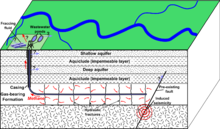Uses
...and 18% is used for metal and household cleaners.[1] In the US it is considered a High Production Volume Chemical because greater than 100 million pounds of this chemical is produced per year.[2]
2-Butoxyethanol is a component in enamels, printing paste and varnish removers, as well as solvent-based building materials such as silicone caulk. Because of this it is a compound commonly found at construction and remodeling sights, automobile repair shops, printing presses, and where sterilizing agents and cleaners are often used. It is also approved by the FDA in the United States to be used as a direct and indirect food additive as an antimicrobial agent, defoamer, stabilizer, and adhesive.[3]
2-Butoxyethanol is also used in hydraulic fracturing. It is used as a product stabilizer, surfactant, and oil slick dispersant for both water-based and oil-based hydraulic fracturing. When the liquid is pumped into the well, 2-Butoxyethanol is used to stabilize the chemicals that are being pumped under extreme pressure by lowering the surface tension and then used to release the oil from the ground by preventing congealing. It is also used as a crude oil-water coupling solvent for more general oil well workovers.[4] Because of its surfactant properties, 2-Butoxyethanol is also used as a major constituent in dispersants for oil spills.[5] It is found in the dispersant Corexit 9527, which was used in the Deepwater Horizon oil spill.[6] Its use in Corexit has incited controversy because of the possible environmental and health effects of the chemical.[7]

- ^ "Ethylene Glycol Mono-N-Butyl Ether". National Library of Medicine. Retrieved 3/26/14.
{{cite web}}: Check date values in:|accessdate=(help) - ^ "Ethylene Glycol Mono-N-Butyl Ether". National Library of Medicine. Retrieved 3/26/14.
{{cite web}}: Check date values in:|accessdate=(help) - ^ Dickey, Robert. "Assessment of the potential impact of COREXIT® oil dispersants on seafood safety" (PDF). Dispersants and Seafood Safety. Retrieved 3/26/14.
{{cite journal}}: Check date values in:|accessdate=(help); Unknown parameter|coauthors=ignored (|author=suggested) (help) - ^ "Ethylene Glycol Mono-N-Butyl Ether". National Library of Medicine. Retrieved 3/26/14.
{{cite web}}: Check date values in:|accessdate=(help) - ^ Dickey, Robert. "Assessment of the potential impact of COREXIT® oil dispersants on seafood safety" (PDF). Dispersants and Seafood Safety. Retrieved 3/26/14.
{{cite journal}}: Check date values in:|accessdate=(help); Unknown parameter|coauthors=ignored (|author=suggested) (help) - ^ Dickey, Robert. "Assessment of the potential impact of COREXIT® oil dispersants on seafood safety" (PDF). Dispersants and Seafood Safety. Retrieved 3/26/14.
{{cite journal}}: Check date values in:|accessdate=(help); Unknown parameter|coauthors=ignored (|author=suggested) (help) - ^ Dickey, Robert. "Assessment of the potential impact of COREXIT® oil dispersants on seafood safety" (PDF). Dispersants and Seafood Safety. Retrieved 3/26/14.
{{cite journal}}: Check date values in:|accessdate=(help); Unknown parameter|coauthors=ignored (|author=suggested) (help)
